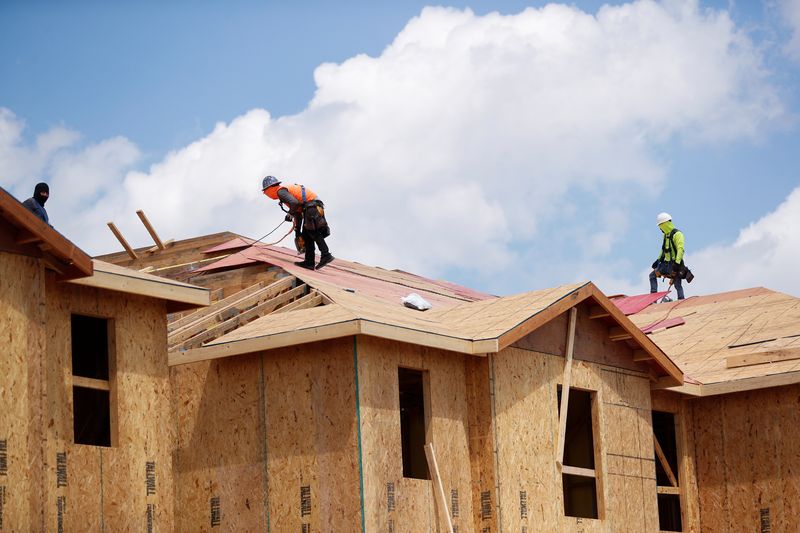By Lucia Mutikani
WASHINGTON (Reuters) -U.S. single-family homebuilding surged to a five-month high in September, but permits for future construction rose only marginally amid excess supply of new homes on the market and prospective buyers holding out for lower mortgage rates.
Despite the second straight monthly increase in single-family housing starts, economists expected that residential investment, which includes homebuilding and sales, remained a drag on third-quarter economic growth.
Homebuilding suffered a setback following a surge in mortgage rates in the spring. Mortgage rates initially dropped after the Federal Reserve began cutting interest rates last month, but they have risen over the past three weeks as solid economic data, including retail sales and annual revisions to national accounts, forced traders to abandon expectations for another 50 basis-point rate cut next month.
"Residential construction activity is not helping the economy grow at its potential rate," said Carl Weinberg, chief economist at High Frequency Economics.
"'Falling' interest rates are different than 'low' interest rates until they have been falling for a while. For builders and buyers, the promise of more rate cuts to come will encourage delaying new construction projects and purchases."
Single-family housing starts, which account for the bulk of homebuilding, increased 2.7% to a seasonally adjusted annual rate of 1.027 million units last month, the Commerce Department's Census Bureau reported on Friday.
Data for August was revised higher to show single-family homebuilding rebounding to a rate of 1.0 million units from the previously reported 992,000-unit pace.
Starts for this segment rose 6.6% in the densely populated South and jumped 10.6% in the Northeast, which is the smallest region in terms of housing construction. But they fell 10.4% in the Midwest, which is considered the most affordable region, and dropped 2.3% in the West.
Single-family homebuilding advanced 5.5% from a year ago. Starts fell at a 15.5% annualized rate in the third quarter after declining at a 20.1% pace in the April-June quarter.
Residential investment subtracted from gross domestic product in the second quarter. Growth estimates for the third quarter are as high as a 3.4% rate. The economy grew at a 3.0% pace in the April-June quarter.
"Starts may be finding a bottom despite still elevated inventories of new homes," said Abiel Reinhart, an economist at J.P. Morgan. "If this holds, then residential investment could turn to a slight positive in the fourth quarter after exhibiting a drag in third quarter."
Stocks on Wall Street were trading mostly higher. The dollar slipped against a basket of currencies. U.S. Treasury yields fell.
LOW BUILDING PERMITS
New construction has benefited in recent years from a dearth of previously owned houses on the market, prior to the spring resurgence in mortgage rates, which sidelined prospective buyers and pushed the supply of new homes on the market to levels last seen in 2008.
Potential homebuyers have also been reluctant to wade back into the market, anticipating even lower borrowing costs.
A National Association of Home Builders survey on Thursday showed a moderate improvement in homebuilder sentiment in October. It also showed a slight rise in the share of builders using incentives such as price cuts to attract buyers.
Starts for housing projects with five units or more declined 4.5% to a rate of 317,000 units in September. Overall housing starts slipped 0.5% to a rate of 1.354 million units.
Economists polled by Reuters had forecast starts would decrease to a rate of 1.350 million units. Housing starts fell 0.7% from a year ago.
Homebuilding could take a temporary hit from Hurricanes Helene and Milton, which devastated Florida and large areas of the U.S. Southeast in late September and early October. But reconstruction after the hurricanes could provide a lift.
Building permits for single-family housing rose 0.3% to a rate of 970,000 units last month. They increased in the West and Midwest, but declined in the Northeast and South. Permits were 1.2% lower compared to September 2023. They rose at a 0.8% pace in the third quarter.
Multi-family building permits plunged 10.8% to a rate of 398,000 units. Building permits as a whole declined 2.9% to a rate of 1.428 million units. They fell 5.7% from a year ago.
The number of houses approved for construction that were yet to be started dropped 0.7% to 282,000 units last month.
The single-family homebuilding backlog fell 2.1% to 143,000 units. The completions rate for that housing segment declined 2.7% to 1.0 million units.
Overall housing completions decreased 5.7% to a rate of 1.680 million units. The number of housing units under construction fell 1.9% to a rate of 1.484 million units.
The inventory of single-family housing under construction rose 0.3% to a rate of 642,000 units.

"We expect renewed falls in long-term interest rates relatively soon, but the impact on housing market activity will be limited, given that the average interest rate on the stock of existing mortgages is just 3.9%, well below current market rates," said Oliver Allen, senior U.S. economist at Pantheon Macroeconomics.
"Meanwhile, a substantial overhang of inventory of new homes relative to sales argues against a sharp increase in new construction."